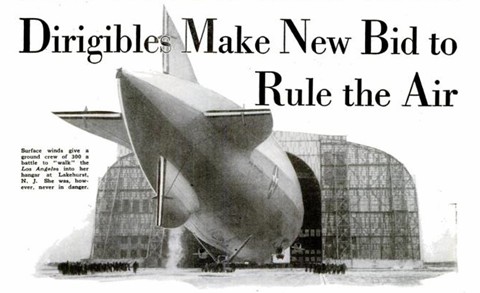
In reading about the recent discovery of an undated film featuring Babe Ruth, we took notice of one of the clues that could yield the clip’s day or origin:
Two college professors separately proposed using the shadows of the flag poles (seen on the field) to determine the position of the sun and, with some serious mathematics, the date of the game. Others noted what appears to be a dirigible in the background over the Bronx and suggested locating dirigible flight schedules.
We stumbled over that dirigible bit, in large part because we very much doubt that late 1920s dirigible flights were frequent enough to merit schedules. But could we be wrong? Could it be that the waning days of the Coolidge Era resembled the fictional world of Watchmen, at least in terms of the preferred means of aerial transport?
A little digging confirmed our suspicions that airship flights were, indeed, a rarity in 1928—although, granted, New York was a destination for transatlantic voyages, and thus that blob in the background could feasibly be a dirigible. But what really jumped out at us during our research was the revelation that airships were considered genuine rivals to airplanes in the late 1920s. This snippet from the great Popular Science article makes the case:
It is an old struggle, this between lighter-than-air and heavier-than-air craft. Which will be the most valuable to man? Who is going to answer? Scientists? Manufacturers? Adventurers? Theorists? None of them: but bookkeppers.For the question has resolved itself into that uncompromising unit of transportation auditors, the ton-mile cost. After due allowance for speed, which type of aircraft will carry a ton of freight a mile for the least amount of money?
More than half the energy expended by an airplane is employed solely to keep the machine in the air. An airship, on the other hand, spends none of its power lifting itself or its load. This vital difference is cited by adherents of lighter-than-air machines as the chief reason why dirigible balloons will win the favor of capital for large scale aerial transportation.
More goodies throughout the piece, whose publication coincided with the debut of Germany’s 127th dirigible, the Graf Zeppelin. Most ominous, perhaps, is the article’s assertion that the Graf Zeppelin will be powered by something called “etan”—”a form of hydrogen gas having the weight of air.” A fateful concept, perhaps?


Jordan // Oct 14, 2009 at 10:27 am
In Freeman Dyson’s “Imagined Worlds”, he makes some really good points about the differences between airships and airplanes and why airships ultimately failed. The biggest was that airships were generally projects designed to maintain the power of nation states and were driven by politics. This led to grandiose creations that were not rigorously tested and tended to ignore the warnings of engineers. So when things inevitably went wrong, it was hard to build up the political will to continue. By contrast, the creation of airplanes was vastly distributed, conducted by hundreds of different firms in the early days. These companies were allowed to make mistakes that led to failures, which weeded out the designs that didn’t work. Thus airplanes were mostly allowed to evolve organically, eventually creating very effective and safe machines. When governments tried to push the creation of particular planes, such as the Concorde, it usually didn’t end up going as planned.
Brendan I. Koerner // Oct 14, 2009 at 10:38 am
Great point by Dyson. The article hints at this, by arguing that airplanes were then more advanced due to much more trial-and-error. (The Graf Zeppelin might’ve been the 127th generation of the technology, but the typical commercial aircraft had benefited from the lessons learned through thousands of production models.) But the author doesn’t make that logical leap to the merits of private innovation over public.
Carlos // Oct 15, 2009 at 11:34 am
Dyson’s emphasis is slightly wrong on this. Turns out that airships were ridiculously labor intensive compared to early airplanes, which were beaters a pilot-mechanic could fix. This priced them out cost per ton-mile. Then airplanes became *efficient*.
(I think we met briefly at Adult Education in Brooklyn a little while back? Friend of Carrie and Charles and Jim.)
Brendan I. Koerner // Oct 15, 2009 at 11:53 am
@Carlos: Hey again! Despite the abundance of post-talk beer, I do, indeed, remember meeting you at Adult Ed last month. Hope to do another one at some point–I proposed something on headhunting, but we’ll have to see if I can squeeze that into one of their themes.
Good point re: factoring in maintenance costs. Something else occurred to me, too, after reading the Pop Sci piece again. It seems the dirigibles were designed to compete only on long haul routes. And for a while there, they could claim absolute supremacy in terms of sheer range–I believe the figure cited in the article is 9k miles for the Graf Zeppelin, which was way longer than any passenger plane at the time. But once planes could do those trans-Pacific routes, dirigibles lost their last edge.
Seriously, I could post about dirigibles all day. Love this stuff, though I can’t quite pinpoint why.